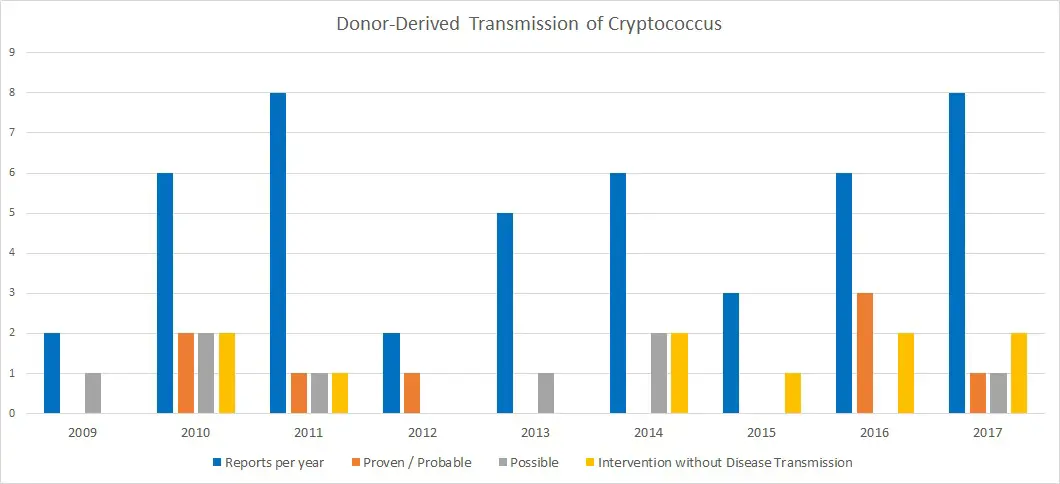Donor-derived Cryptococcosis: A Rare Event
Published on: Thursday, July 11, 2019
You can find the Cryptococcus fungus in soil, trees, and bird droppings. Cryptococcosis, the disease due to Cryptococcus, can occur in both immunocompetent and immunosuppressed individuals. The disease can manifest as meningitis, pneumonia, soft tissue infection, or disseminated type. It can be a reactivation of latent infection in a solid organ transplant recipient, or the candidate can acquire it through a donor-related transmission or if they inhale the organism from environmental sources. Diagnosis of cryptococcosis can be confirmed by fungal culture, cryptococcal antigen in blood or body fluid, or histopathology. Because of its yeast appearance in a clinical specimen, it can be confused with Candida spp. If you suspect Cryptococcus, you should request specific testing from a microbiology laboratory to differentiate Cryptococcus from Candida spp.
The OPTN Ad hoc Disease Transmission Advisory Committee (DTAC) evaluated the potential donor-derived transmission events (PDDTE) of Cryptococcus reported to the OPTN between 2008-2017 [1] (Figure 1). Of the 46 reported PDDTE cases of Cryptococcus, eight donors resulted in proven/probable disease transmission to 14 recipients (8 kidney, 3 liver, 2 lungs, and 1 heart).
Disease presentation in the recipients included:
- meningitis (n= 7 with one fatality)
- fungemia (n=2)
- skin nodules (n=2)
- pneumonia (n=1)
One individual was asymptomatic but tested due to disease in another recipient of the same donor; their only evidence of infection was a detectable serum cryptococcal antigen. Two other recipients were diagnosed incidentally by routine respiratory cultures; but, otherwise, were asymptomatic. Diagnosis of infection in these recipients occurred between 8 and 81 days after transplantation. The organ donors, retrospectively, had subacute to chronic symptoms, including headache (n=4), mental status change (n=4), gait instability or falls (n=3) and seizure (n=1) before death. Notably, five donors had intracranial hemorrhage or stroke as the cause of death.

Figure 1. Donor-Derived Transmissions of Cryptococcus over 10 years
Donor-derived transmissions of Cryptococcus is rare. Per the data obtained by DTAC, donors who may be infected with Cryptococcus can either be asymptomatic or may have unexplained neurologic symptoms, including stroke. The latter warrants careful evaluation of these potential donors and requires discussion with the potential recipient. The guidance for recognizing central nervous system infection in potential deceased donors was previously issued by DTAC in a prior publication. Identifying cryptococcosis in a recipient in the early post-transplant period should raise concern for a donor-derived transmission and you should report it to the OPTN’s Patient Safety Portal. Your report enables them to begin a swift investigation and begin intervention to protect other recipients from the same donor.
References:
1. Mehta AK, Malinis M, Vece G, Danziger-Isakov L, Florescu DF, Strasfeld L, Tlusty S, Michaels M, Wolfe CR. 10 Years of DTAC Experience with Donor-Derived Cryptococcus Transmission in Solid Organ Transplantation in the US Abstract 73028 IDWeek 2018TM, San Francisco, CA. Oct 6, 2018.
View the Disease Transmission Advisory Committee's quarterly data updates and find meeting minutes and links to other resources.


